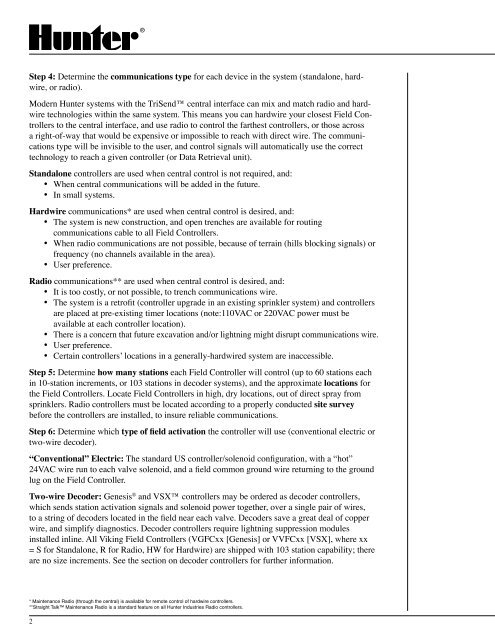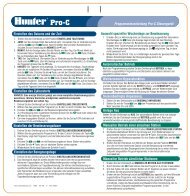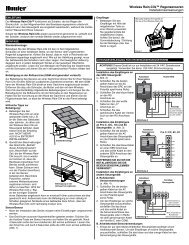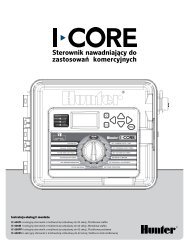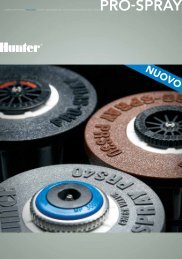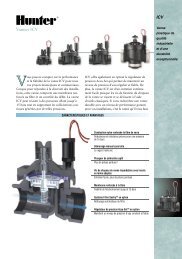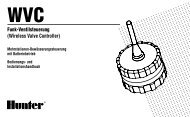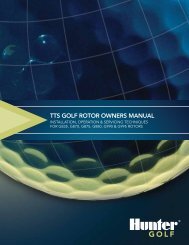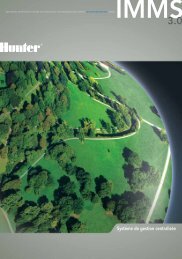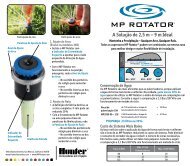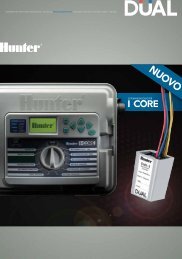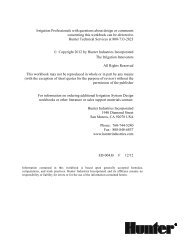Hunter Control System Design Guide - Hunter Industries
Hunter Control System Design Guide - Hunter Industries
Hunter Control System Design Guide - Hunter Industries
- No tags were found...
Create successful ePaper yourself
Turn your PDF publications into a flip-book with our unique Google optimized e-Paper software.
Step 4: Determine the communications type for each device in the system (standalone, hardwire,or radio).Modern <strong>Hunter</strong> systems with the TriSend central interface can mix and match radio and hardwiretechnologies within the same system. This means you can hardwire your closest Field <strong>Control</strong>lersto the central interface, and use radio to control the farthest controllers, or those acrossa right-of-way that would be expensive or impossible to reach with direct wire. The communicationstype will be invisible to the user, and control signals will automatically use the correcttechnology to reach a given controller (or Data Retrieval unit).Standalone controllers are used when central control is not required, and:• When central communications will be added in the future.• In small systems.Hardwire communications* are used when central control is desired, and:• The system is new construction, and open trenches are available for routingcommunications cable to all Field <strong>Control</strong>lers.• When radio communications are not possible, because of terrain (hills blocking signals) orfrequency (no channels available in the area).• User preference.Radio communications** are used when central control is desired, and:• It is too costly, or not possible, to trench communications wire.• The system is a retrofit (controller upgrade in an existing sprinkler system) and controllersare placed at pre-existing timer locations (note:110VAC or 220VAC power must beavailable at each controller location).• There is a concern that future excavation and/or lightning might disrupt communications wire.• User preference.• Certain controllersʼ locations in a generally-hardwired system are inaccessible.Step 5: Determine how many stations each Field <strong>Control</strong>ler will control (up to 60 stations eachin 10-station increments, or 103 stations in decoder systems), and the approximate locations forthe Field <strong>Control</strong>lers. Locate Field <strong>Control</strong>lers in high, dry locations, out of direct spray fromsprinklers. Radio controllers must be located according to a properly conducted site surveybefore the controllers are installed, to insure reliable communications.Step 6: Determine which type of field activation the controller will use (conventional electric ortwo-wire decoder).“Conventional” Electric: The standard US controller/solenoid configuration, with a “hot”24VAC wire run to each valve solenoid, and a field common ground wire returning to the groundlug on the Field <strong>Control</strong>ler.Two-wire Decoder: Genesis ® and VSX controllers may be ordered as decoder controllers,which sends station activation signals and solenoid power together, over a single pair of wires,to a string of decoders located in the field near each valve. Decoders save a great deal of copperwire, and simplify diagnostics. Decoder controllers require lightning suppression modulesinstalled inline. All Viking Field <strong>Control</strong>lers (VGFCxx [Genesis] or VVFCxx [VSX], where xx= S for Standalone, R for Radio, HW for Hardwire) are shipped with 103 station capability; thereare no size increments. See the section on decoder controllers for further information.* Maintenance Radio (through the central) is available for remote control of hardwire controllers.**Straight Talk Maintenance Radio is a standard feature on all <strong>Hunter</strong> <strong>Industries</strong> Radio controllers.2


